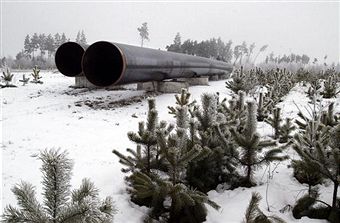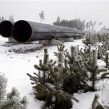
Bait and Switch: Russia Multiplies Gas Route Offers to Europe
Publication: Eurasia Daily Monitor Volume: 10 Issue: 75
By:

Russian President Vladimir Putin and Gazprom are announcing colossal plans to expand the capacities of existing gas export pipelines and build new ones, all in Europe beyond Russia’s territory (see EDM, April 5, 19).
Gazprom already co-owns and controls export pipeline capacities amounting to some 110 billion cubic meters (bcm) per year in Europe beyond Russia (Nord Stream One and Two, Yamal-Europe, the export pipelines to the Baltic States and Finland, and Blue Stream), including more than 90 bcm per year in pipelines located within the European Union. Apart from this, Russia remains the sole user (albeit at decreasing annual usage levels) of Ukraine’s state-owned pipeline system with its westbound transit capacity of 140 bcm per year. Moscow now proposes to build new pipelines with capacities amounting to some 130 bcm per year (Nord Stream Three and Four, “Yamal-Europe Two,” South Stream), all within EU territory.
Thanks to the recently completed Nord Stream One and Two (2011–2012), Russia has some 250 bcm per year in export pipeline capacities at its disposal in Europe; and would increase that to a grand total of some 380 bcm per year, if the new projects are completed as proposed. Meanwhile, Gazprom’s current sales in Europe are down to some 150 bcm of gas annually in the framework of long-term supply commitments, with only scant hopes to regain Gazprom’s pre-crisis export levels of some 180 bcm annually in a post-crisis Europe. Moreover, Russia faces the prospect of a net loss of overall market share due to growing competition from liquefied gas on European markets (see EDM, April 19).
Why, then, does Russia offer all those new export pipelines to Europe, at colossal capacities and costs? No fully satisfactory answers to this question appear to exist (Russian steel industry’s profiteering at state expense would be one such answer). But some grand policy objectives are clearly discernible behind the various pipeline proposals. Several of these proposals amount to sheer bluffs, offering basically the same gas volumes to different groups of recipient and transit countries along the proposed pipeline routes. This procedure is apt to generate competition among potential recipient and transit countries and national champion companies over priority access to Russian gas.
The proposals also seek to enlist certain European governments and partner companies into a resistance front against the EU’s Third Package of energy market legislation. If properly implemented, that legislation could compel Gazprom to divest itself of infrastructure it owns through joint ventures in EU territory, which form parts of vertically integrated monopoly arrangements. Moscow, however, proposes further expansion into the EU through joint pipeline projects. It hopes to roll back the EU’s Third Legislative Package, with the help of those vested interests that Gazprom’s joint ventures have already created in Europe.
Gazprom chief spokesman Sergei Kupryanov’s list of pipelines beyond Russia’s territory that Gazprom plans to use in the future (East European Gas Analysis via www.naturalgaseurope.com, accessed April 16) strikingly excludes Ukraine’s state-owned transit system. Gazprom is announcing a new principle whereby it would only use those pipelines in Europe in which Gazprom holds at least 50 percent ownership. It lists specifically Nord Stream, Yamal-Europe, South Stream, Blue Stream).
This message has many intended audiences. By excluding Ukraine it threatens that country with re-routing most of the transit flow from Ukrainian pipelines into bypass routes, reducing Ukrainian transit to a trickle, unless Ukraine would agree to share control of its transit system with Gazprom. The demand is familiar, but the public threat of full exclusion based on ownership criteria is new (see EDM, April 5, 10).
Governments and companies interested in Gazprom’s South Stream and the Nord Stream Three and Four know that these projects largely depend on gas flows being re-directed toward them from other pipelines, existing or planned. Those Stream projects can only exist by draining Ukraine’s transit pipelines, and reassigning to Nord Stream any gas volumes that could have gone into the proposed Yamal-Europe Two pipeline (see EDM, April 10). In this situation, lacking new significant volumes of gas for export, Moscow is using bait-and-switch tactics on the various interested parties.
While raising expectations among South Stream participants, Moscow tells Ukraine at the same time that it would “guarantee” a transit volume of at least 60 bcm per year through Ukrainian pipelines, if Ukraine turns its transit pipelines to a joint venture with Gazprom (Interfax-Ukraine, April 7). This, however, would reduce South Stream to a trickle and render that whole project unjustifiable.
Similarly, Putin and Gazprom CEO Alexei Miller proposed in early April to initiate the Nord Stream Three and Four project, concluding a preliminary agreement of intent with the Netherlands. But just days later, Gazprom went on to sign a memorandum of understanding on a “Yamal-Europe Two” project via Poland, southward into Central Europe, bypassing Ukraine. And within days again, Gazprom announced that the same “Yamal-Europe Two” volumes might be assigned to Nord Stream on the Baltic seabed. This would imply that several Central European countries could still be supplied with gas via Ukraine, if Ukraine accepts Gazprom’s terms on pipeline ownership. And that in turn makes the diehard South Stream believers nervous again.




